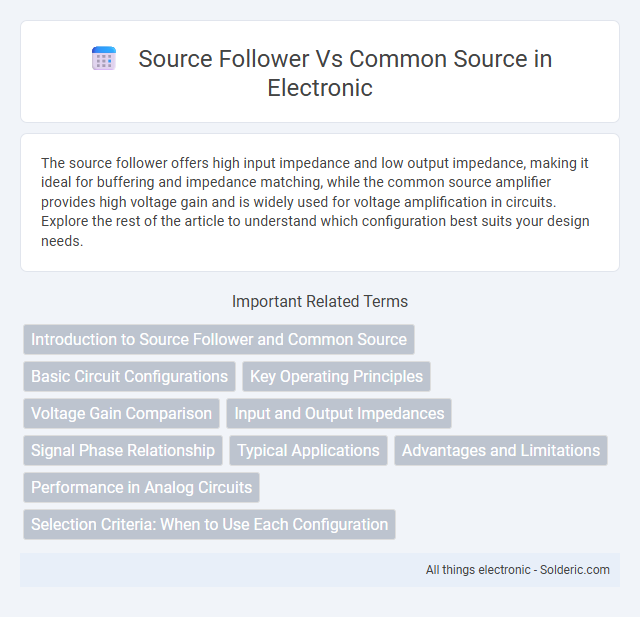The source follower offers high input impedance and low output impedance, making it ideal for buffering and impedance matching, while the common source amplifier provides high voltage gain and is widely used for voltage amplification in circuits. Explore the rest of the article to understand which configuration best suits your design needs.
Comparison Table
| Feature | Source Follower (Common Drain) | Common Source |
|---|---|---|
| Configuration | Output taken from source terminal | Output taken from drain terminal |
| Voltage Gain | Approx. 1 (Unity) | High voltage gain (>1) |
| Input Impedance | High input impedance | High input impedance |
| Output Impedance | Low output impedance | High output impedance |
| Phase Shift | 0deg (No inversion) | 180deg (Inversion) |
| Applications | Impedance matching, buffer stages | Amplification, small-signal voltage gain |
| Current Gain | Greater than 1 | Greater than 1 |
Introduction to Source Follower and Common Source
The Source Follower and Common Source are fundamental FET amplifier configurations used in analog circuits. The Source Follower, also known as the common drain amplifier, provides a high input impedance and a voltage gain close to unity, making it ideal for impedance matching and buffering. The Common Source amplifier offers high voltage gain and moderate input impedance, suitable for amplifying weak signals in various electronic applications.
Basic Circuit Configurations
The source follower, also known as the common drain configuration, features the input applied to the gate, the source as the output, and the drain connected to the supply voltage, providing a voltage gain slightly less than one with high input impedance and low output impedance. In contrast, the common source configuration has the input at the gate, the source connected to ground, and the output taken from the drain, offering high voltage gain and moderate input/output impedances suitable for amplification purposes. Understanding these basic circuit configurations helps you choose the right topology for buffering or amplifying signals in analog circuits.
Key Operating Principles
A source follower operates with the input signal applied to the gate and the output taken from the source, providing a voltage gain close to unity while offering high input impedance and low output impedance. The common source amplifier, with the input at the gate and output at the drain, provides significant voltage gain due to the transistor's transconductance but has moderate input and higher output impedance. Your choice between these configurations depends on whether voltage gain or impedance matching is the primary requirement in your circuit design.
Voltage Gain Comparison
The source follower, also known as a common drain amplifier, typically provides a voltage gain slightly less than unity, making it ideal for impedance matching rather than signal amplification. In contrast, the common source amplifier offers significant voltage gain, often exceeding 10, by providing high output resistance and voltage amplification from the input signal. When optimizing your circuit for voltage gain, selecting a common source configuration is preferable over a source follower, which prioritizes voltage buffer applications.
Input and Output Impedances
Source followers exhibit high input impedance and low output impedance, making them ideal for impedance matching and buffering applications. Common source amplifiers have moderate input impedance and relatively high output impedance, which allows for significant voltage gain but less effective driving capability. The contrasting impedance characteristics influence their roles, with the source follower serving as a voltage buffer and the common source serving as a voltage amplifier.
Signal Phase Relationship
In a source follower configuration, the output voltage is in phase with the input voltage, resulting in a unity gain buffer ideal for impedance matching. Conversely, a common source amplifier produces an output signal that is 180 degrees out of phase with the input, providing voltage gain with phase inversion. Understanding this phase relationship is critical for designing amplification stages in analog circuits where signal phase integrity or inversion is required.
Typical Applications
Source followers are commonly used in buffer stages, impedance matching, and voltage level shifting due to their high input impedance and unity voltage gain. Common source amplifiers find typical applications in voltage amplification circuits such as audio amplifiers and RF amplifiers, where high voltage gain is essential. Both configurations are fundamental in analog circuit design, with source followers prioritizing signal integrity and common source stages optimizing gain.
Advantages and Limitations
Source follower circuits offer high input impedance and unity voltage gain, making them ideal for impedance matching and buffering applications. Common source amplifiers provide substantial voltage gain and good output impedance characteristics, suitable for signal amplification. However, source followers have limited voltage gain, while common source stages can suffer from lower input impedance and potential distortion at high frequencies.
Performance in Analog Circuits
Source followers offer high input impedance and low output impedance, making them ideal for buffering and signal isolation in analog circuits. Common source amplifiers provide significant voltage gain but have higher output impedance, which can limit driving capability in certain applications. Your choice depends on whether you prioritize voltage gain or signal buffering in the circuit design.
Selection Criteria: When to Use Each Configuration
Source follower configurations excel in applications requiring high input impedance and voltage buffering with unity gain, making them ideal for impedance matching and voltage level translation. Common source amplifiers offer high voltage gain and are suited for voltage amplification where signal boosting is essential, especially in small-signal analog circuits. Your selection depends on whether your design prioritizes impedance matching and low output impedance (source follower) or high voltage gain (common source).
Source follower vs Common source Infographic

 solderic.com
solderic.com